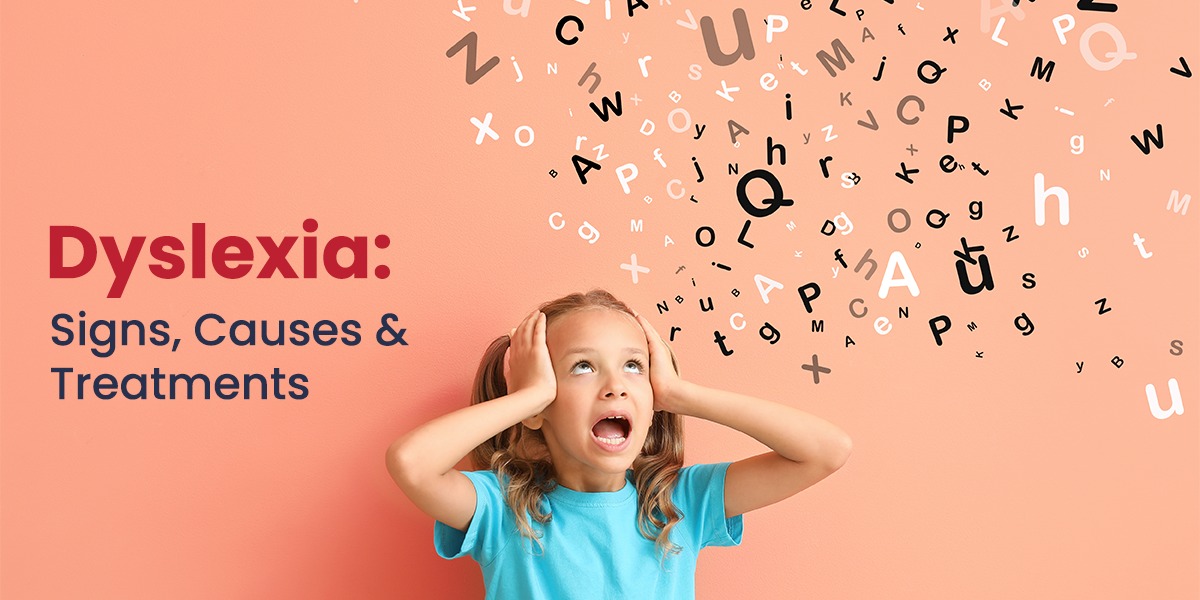Dyslexia Decoded: Symptoms, Causes & Breakthrough Treatments!

Dyslexia is regarded as a learning disability among individuals where the brain shows the symptoms of an inability to recollect, read and comprehend situations promptly. People who are affected by dyslexia often end up with a cognitive disability and difficulty reading and learning a new language or anything new related to skill development. Dyslexia symptoms are treatable; individuals often live a normal life without hindrance after proper dyslexia treatment.
Refer to the best neurologist in Kanpur and Lucknow to diagnose the causes and assess the symptoms of dyslexia for speedy recovery.
What Is Dyslexia?
Dyslexia is a classic learning disability syndrome among individuals. Dyslexia causes difficulty in processing by the brain, and most of the time, the symptoms are identified during childhood and addressed accordingly. Although it is a lifelong issue, dyslexia can be cured and improved with therapy and treatment. This is also known as developmental dyslexia. One might be confused about what is dyslexia as the symptoms are quite diverse and sometimes challenging to assess.
Dyslexia is often considered as a specific learning disorder which is categorised into three different forms:
- Writing (dysgraphia)
- Math (dyscalculia)
- Reading (dyslexia)
How Dyslexia Creates Difficulty in Understanding a New Language
Reading starts with learning to spell the spoken language. It commences with making sounds for the kids. Then, it moves to learning phrases and then small sentences. Following that, a child is taught to spell while reading. And this is where ‘what is dyslexia’ comes into play. This interferes with the ability of the brain to decode the spoken language. The brain has problems processing the words and relating sounds with their respective alphabet.
This slows down the overall process of reading and processing the meaning behind it. Dyslexia creates problems in reading and writing and hinders remembrance. An individual with dyslexia has trouble forming sentences to communicate a more complex idea.
Dyslexia Symptoms
Here are some of the common Dyslexia symptoms that one comes across:
- Having difficulty in spelling simple words.
- Showing difficulty learning the letters and alphabet.
- Showing trouble in distinguishing between “p” and “q”, “d” and “b”.
- Showing signs of difficulty in rhyming.
- Ignorant to read out loud in a community.
- Showcasing trouble to read out new words.
- Mixing up different sounds and having trouble distinguishing different words and their meanings
Having multiple such symptoms showcases that one might have dyslexia. Learning the basic skills in such cases can be difficult, and dyslexia tests and screening processes are available to help comprehend the underlying causes. Comprehending what is dyslexia through its symptoms can help to address it faster.
Different Levels of Severity
Wondering what is dyslexia and how to understand the signs? Dyslexia may show up in different stages of severity, which are as follows:
- Mild: When it is manageable, you can still conduct regular chores without much difficulty talking, reading, and writing.
- Moderate: There can be moderate difficulty in processing thoughts and conveying emotions. When addressed in time, it can be cured.
- Severe: Acute difficulty even pronouncing the basic phrases and requires immediate and specialised intervention from experts.
Management and Treatments for Dyslexia
Dyslexia treatment includes:
- Speech therapies and interventions by experts to understand the complications and cure them.
- No medication as much exists for dyslexia, but therapy can be beneficial for cure.
- New and comprehensive reading skills are introduced by experts to help an individual.
- Sometimes, slowing down the teaching process for kids can help them grasp the material better.
- Moreover, spend time reading every word aloud to your kids. By progressively working on the skills of reading and writing, the symptoms of Dyslexia can be minimised.
- It is a condition that your child does not have control over. Hence you need to be patient and understanding about their situation. Pressurising them to read and learn rapidly can worsen the state.
- Dyslexia in adults is also treatable as long as it is recognised and addressed promptly. There are both tools and programs available to help adults with the state of dyslexia. An individual no matter which age can show signs of dyslexia and when so, it needs gradual and thoughtful action.
Conclusion
Dyslexia is not a disease but a state or condition of less intelligence and reduced cognitive action of the brain. While it is curable, there is no way to prevent it. Through therapies and actions, an individual with dyslexia can excel in their field and show a higher IQ than any other person. If you suspect signs of dyslexia in your child, take them to an expert to seek help immediately. Consulting the physician at the right time can treat dyslexia successfully.
You may also read: Neurological Disorders: Signs, Types, Causes and Symptoms

 Call-an-Ambulance
Call-an-Ambulance



